ISSN ONLINE(2319-8753)PRINT(2347-6710)
ISSN ONLINE(2319-8753)PRINT(2347-6710)
D. Srikanth1, M.V.S. Murali Krishna2, P.Ushasri3 and P.V. Krishna Murthy4
|
| Related article at Pubmed, Scholar Google |
Visit for more related articles at International Journal of Innovative Research in Science, Engineering and Technology
It has been found that the vegetable oils are promising substitute, because of their properties are similar to those of diesel fuel and they are renewable and can be easily produced. However, drawbacks associated with crude vegetable oils are high viscosity, low volatility call for low heat rejection diesel engine. Comparative studies were made on performance evaluation of medium grade LHR diesel engine (with air gap insulated piston with superni ( an alloy of nickel) crown and air gap insulated liner with superni insert) and conventional diesel engine (CE) with different operating conditions [normal temperature and pre-heated temperature] of crude cotton seed oil with varied injector opening pressure and injection timing. Performance parameters [brake thermal efficiency, brake exhaust gas temperature, volumetric efficiency, sound levels and coolant load], exhaust emissions [smoke levels and oxides of nitrogen] were determined at various values of brake mean effective pressure of the engine. Combustion characteristics (peak pressure, maximum rate of pressure rise and time of occurrence of peak pressure) were evaluated at peak load operation of the engine. Conventional engine showed deteriorated performance, while LHR engine showed improved performance with cotton seed oil at recommended injection timing and pressure in comparison with pure diesel operation on CE. The optimum injection timing was 32obTDC with conventional engine, while it was 30obTDC for LHR engine with cotton seed oil operation
Keywords |
| Alternate Fuels, LHR engine, Fuel Performance, Exhaust emissions, Combustion characteristics |
INTRODUCTION |
| In the context of i) fast depletion of fossil fuels, ii) increase of pollution levels with fossil fuels and ii) ever increases of fuel prices in International market, the search for alternate fuels has become pertinent. Alcohols and vegetables oils are important substitutes for diesel fuel. Alcohols have high volatility and low cetane number. Hence engine modification is necessary for alcohols if they are to be substituted for diesel fuels. That too, most of the alcohols produced in India are diverted for Petro-chemical industries. On the other hand, vegetable oils have high cetane number and low volatility. Rudolph diesel, the inventor of the engine that bears his name experimented [1] with fuels ranging from powdered coal to peanut oil. Several researchers [2-8] experimented the use of vegetable oils as fuel on conventional engines and reported that the performance was poor, citing the problems of high viscosity, low volatility and their polyunsaturated character. Viscosity can be reduced with preheating. Experiments were conducted [9-12] on preheated vegetable [temperature at which viscosity of the vegetable oils were matched to that of diesel fuel] oils and it was reported that preheated vegetable oils improved the performance marginally, decreased exhaust emissions of smoke and NOx emissions. |
| Few investigators [13-15] reported that injector opening pressure has a significance effect [16] on the performance and formation of pollutants inside the direct injection diesel engine combustion. |
| The drawbacks associated with vegetable oils call for LHR engine which provide hot combustion chamber for burning these fuels. |
| The concept of LHR engine is to minimize heat loss to the coolant by providing thermal insulation in the path of the coolant thereby increases the thermal efficiency of the engine. LHR engines are classified depending on degree of insulation as low grade, medium grade and high grade LHR engines. Low grade LHR engines provide ceramic coatings on piston, liner and cylinder head. Medium grade LHR engine contain air gap insulated components. High grade LHR engines consist of ceramic coatings on engine components and air gap insulation. |
| Investigations were carried out [17-19] on ceramic coated LHR engines fuelled with pure diesel operation. It was reported from their investigations that ceramic coatings provided adequate insulation and improved brake specific fuel consumption in the range of 5-8% at peak load operation. Studies were made [20-22] on ceramic coated diesel engines with vegetable oils. It was revealed from their investigations LHR engine improved performance marginally, decreased smoke levels by 30% and increased NOx emissions by 40%. |
| Experiments were conducted [23-25] with medium grade LHR engines with vegetable oils. It was reported that LHR engine improved the performance, decreased smoke emissions by 40% and increased NOx levels by 50% Investigations [26-28] were carried out on high grade LHR engines. It was revealed from their investigations high grade LHR engines improved performance, decreased smoke levels by 50% and increased NOx levels by 60%. Sound intensity is the important parameter to determine the combustion phenomena. Very few studies [29-31] were made on LHR engine to assess the sound intensity particularly in LHR engine. Comparative studies were made on CE and medium grade LHR engine with difference conditions of crude cotton seed oil with varied injection timing and injector opening pressure. |
| Section-2 contains Materials and Methods, Section-3 contains Results and Discussions, Section-4 consists of Conclusions, Section-5 contains Future scope of work, Section-6 contains Acknowledgements followed by References followed. |
MATERIALS AND METHODS |
| This section contains fabrication of medium grade LHR engine, properties of crude vegetable oil, description of experimental setup and specification of the experimental engine. |
| Fabrication of medium grade LHR engine: The low heat rejection diesel engine contains a two-part piston- the top crown made of low thermal conductivity material, superni-90 was screwed to aluminum body of the piston, providing a 3mm-air gap in between the crown and the body of the piston The optimum thickness of air gap in the air gap piston is found to be 3 mm [ ] for improve performance of the engine with superni inserts with diesel as fuel. A superni-90 insert is screwed to the top portion of the liner in such a manner that an air gap of 3mm is maintained between the insert and the liner body. The properties and composition of superni-90 material are shown in Table 1 and Table-.2 respectively. At 500oC the thermal conductivity of superni-90 and air are 20.92 and 0.057 W/m-K respectively. |
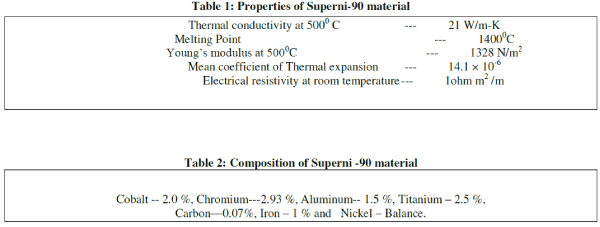 |
| Properties of crude vegetable oil: The physico-chemical properties of the cotton seed oil in comparison with pure diesel are presented in Table 3. Cotton seed oil was heated to a temperature (preheated temperature-95oC) till its viscosity was matched to that of diesel fuel. |
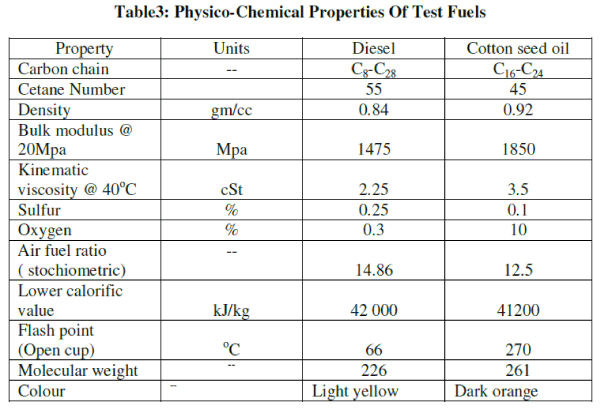 |
| The specifications of the test engine were given in Table 4. The experimental setup used for the investigations of LHR diesel engine with crude cotton seed oil is shown in Fig 1. The combustion chamber consisted of a direct injection type with no special arrangement for swirling motion of air. The engine was connected to an electric dynamometer for measuring its brake power. Burette method was used for finding fuel consumption of the engine. Air-consumption of the engine was measured by an air-box method( It was provided with an orifice meter, u-tube water manometer). The naturally aspirated engine was provided with water-cooling system in which inlet temperature of water was maintained at 80oC by adjusting the water flow rate. Engine oil was provided with a pressure feed system. No temperature control was incorporated, for measuring the lube oil temperature. Copper shims of suitable size were provided in between the pump body and the engine frame, to vary the injection timing (so there is change of length plunger of pump barrel) and its effect on the performance of the engine was studied. Injector opening pressure was varied from 190 bar to 270 bar (in steps of 40 bar) using nozzle testing device. The maximum injector opening pressure was restricted to 270 bar due to practical difficulties involved. Exhaust gas temperature was measured with thermocouples made of iron and ironconstantan. Exhaust emissions of smoke and NOx were recorded by AVL (A company trade name) smoke meter and Netel (A- company trade name) Chromatograph NOx analyzer respectively at various values of brake mean effective pressure of the engine. Sound intensity was measured with sound analyzer at different values of brake mean effective pressure of the engine. The specifications of the analyzers were given in Table-5. |
| Piezo electric transducer, fitted on the cylinder head to measure pressure in the combustion chamber was connected to a console, which in turn was connected to Pentium personal computer. TDC (top dead centre) encoder provided at the extended shaft of the dynamometer was connected to the console to measure the crank angle of the engine. A special P-ïÃÂñ software package evaluated the combustion characteristics such as peak pressure (PP), time of occurrence of peak pressure (TOPP) and maximum rate of pressure rise (MRPR) from the signals of pressure and crank angle at the peak load operation of the engine. Pressure-crank angle diagram was obtained on the screen of the personal computer. |
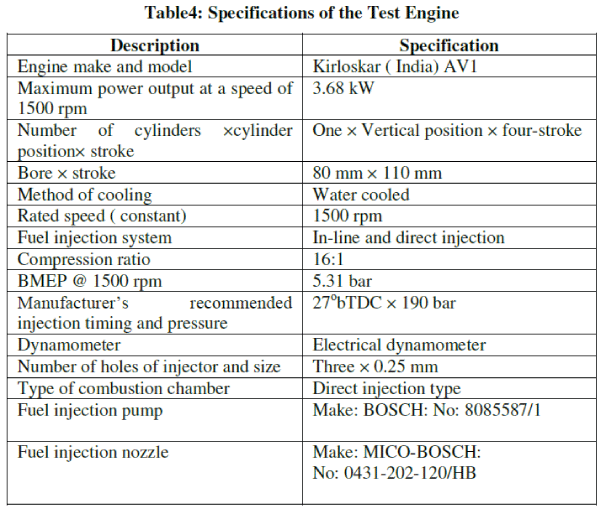 |
 |
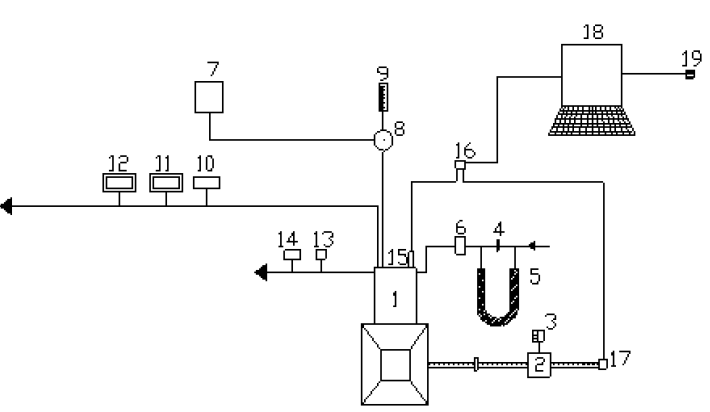 |
| 1.Engine, 2.Electical Dynamo meter, 3.Load Box, 4.Orifice meter, 5.U-tube water manometer, 6.Air box, 7.Fuel tank, 8, Preheater, 9.Burette, 10. Exhaust gas temperature indicator, 11.AVL Smoke meter, 12.Netel Chromatograph NOx Analyzer, 13.Outlet jacket water temperature indicator, 14. Outlet-jacket water flow meter, 15.Piezo-electric pressure transducer, 16.Console, 17.TDC encoder, 18.Pentium Personal Computer and 19. Printer. |
| Fig.1 Experimental Set-up |
| The test fuels used in the experimentation were pure diesel and crude cotton seed oil. The various configurations of the engine were conventional engine, and LHR engine. Different operating conditions of the vegetable oil were normal temperature (NT) and preheated temperature (PT). Different injector opening pressures attempted in this experimentation were 190 bar, 230 bar and 270 bar. Various injection timings attempted in the experimentation were 27-34obTDC. |
RESULTS AND DISCUSSION |
| A. Performance Parameters |
| The optimum injection timing for diesel operation was 31obTDC, for CE, while it was 30obTDC for LHR engine with pure diesel operation [23]. |
| Curves from Figure 2 indicate brake thermal efficiency increased up to 80% of the full load and beyond that load it decreased in conventional engine with test fuels at different injection timings. This was due to increase of fuel conversion up to 80% of peak load. Beyond 80% of peak load, air fuel ratios got reduced as oxygen was completely used up [23]. Conventional engine operated with crude cotton seed oil (CSO) showed deteriorated performance at all loads when compared with the pure diesel operation on conventional engine at 27obTDC. This was due to higher viscosity and accumulation of carbon on nozzle tip with cotton seed oil. In addition, less air entrainment [23] by the fuel spay suggested that the fuel spray penetration might increase and resulted in more fuel reaching the combustion chamber walls. |
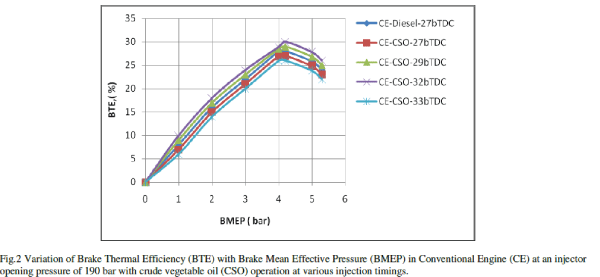 |
| Furthermore droplet mean diameters (expressed as Sauter mean) were larger [23] for vegetable oil leading to reduce the rate of heat release [23] as compared with diesel fuel. This also, contributed the higher ignition (chemical) delay of the vegetable oil due to lower cetane number. According to the qualitative image of the combustion under the crude vegetable oil operation with CE, the lower BTE was attributed to the relatively retarded and lower heat release rates [23]. BTE increased with the advanced injection timing with CE with the vegetable oil at all loads, when compared with CE at the recommended injection timing and pressure. This was due to initiation of combustion at earlier period and efficient combustion with increase of air entrainment in fuel spray giving higher brake thermal efficiency. BTE increased at all loads when the injection timing was advanced to 32obTDC in the conventional engine at the normal temperature of crude vegetable oil. The increase of brake thermal efficiency at optimum injection timing over the recommended injection timing with vegetable oil with conventional engine could be attributed to its longer ignition delay and combustion duration. |
| Brake thermal efficiency increased at all loads when the injection timing was advanced to 32obTDC in conventional engine, at the preheated temperature of also. The performance improved further with conventional engine with the preheated vegetable oil for entire load range when compared with normal vegetable oil. Preheating of the vegetable oil reduced the viscosity, which improved the spray characteristics of the oil and reduced the impingement of the fuel spray on combustion chamber walls, causing efficient combustion thus improving brake thermal efficiency. |
| Curves from Fig.3 indicate that LHR version of engine with crude vegetable oil operation at recommended injection timing showed improvement in the performance for the entire load range compared with conventional engine with pure diesel. High cylinder temperatures helped in improved evaporation and faster combustion of the fuel injected into the combustion chamber. Reduction of ignition delay of the crude vegetable oil in the hot environment of the LHR engine improved heat release rates [23] and efficient energy utilization. |
| Preheating of vegetable oil improved performance further in LHR version of the engine. The optimum injection timing was found to be 30obTDC with LHR engine with normal vegetable oil. Since the hot combustion chamber of LHR engine reduced ignition delay and combustion duration and hence the optimum injection timing was obtained earlier with LHR engine when compared with conventional engine with the vegetable oil operation. |
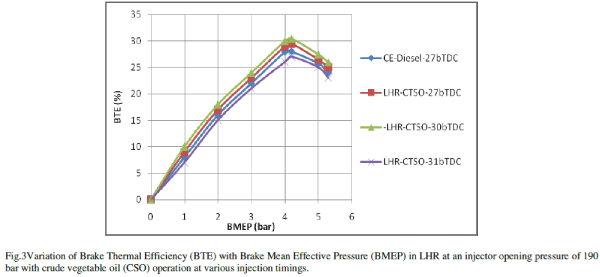 |
| Injector opening pressure was varied from 190 bars to 270 bar to improve the spray characteristics and atomization of the vegetable oils and injection timing was advanced from 27 to 34obTDC for CE and LHR engine. |
| From Table 6, it could be noticed that brake thermal efficiency increased with increase in injector opening pressure in both versions of the engine at different operating conditions of the vegetable oil. The improvement in brake thermal efficiency at higher injector opening pressure was due to improved fuel spray characteristics. The optimum injection timing was 32obTDC at 190 bar, 31obTDC at 230 bar and 30obTDC at 270 bar for conventional engine. This was due to change of ignition delay with respect to injector opening pressure. However, the optimum injection timing was not varied even at higher injector opening pressure with LHR engine, unlike the conventional engine. The optimum injection timing for LHR engine was 30obTDC irrespective of injector opening pressure. This was due to decrease of gas temperatures [23]. Peak brake thermal efficiency was higher in LHR engine when compared with CE with different operating conditions of the vegetable oil. |
| Preheated vegetable oil showed marginally higher BTE than normal vegetable oil. This was due to improvement in spray characteristics with improved air fuel rations [23]. |
| LHR engine gave higher BTE than CE with vegetable oil operation at recommended (11%)and optimized (3%) injection timing. This was because of improved heat release rate [23] with LHR engine. The reasons for deterioration in the performance of CE were high viscosity, low volatility and low calorific value of crude vegetable oil. |
| LHR engine gave higher BTE than CE with diesel operation at recommended (4%) and lower BTE (3%) at optimized injection timing. This was because of improved heat air fuel rations [23] with LHR engine at recommended injection timing up to 80% of peak load operation (23). The reasons for deterioration in the performance of LHR at optimized injection timing were reduction of ignition delay. |
| CE with pure diesel operation showed improved BTE, while LHR engine with crude vegetable oil showed improved BTE with vegetable oil operation. LHR engine was more suitable for crude vegetable oil operation, while CE was more suitable for diesel operation. |
 |
| Generally brake specific fuel consumption, is not used to compare the two different fuels, because their calorific value, density, chemical and physical parameters are different. Brake specific energy consumption (BSEC) defined as energy consumed by the engine in producing I kW brake power. Lesser is the value of BSEC, the better the performance of the engine. From Table 7, brake specific energy consumption (BSEC) at peak load operation decreased with the advanced injection timing and increase of injector opening pressure with both versions of the engine with different operating conditions of vegetable oil. This was due to initiation of combustion at earlier period and efficient combustion with improved air fuel ratios [23] giving lower value of brake specific energy consumption. Bulk modulus of the fuel increased with increase of injector opening pressure leading to generate higher peak pressure leading to reduce the value of brake specific energy consumption. |
| BSEC was lower with preheated vegetable oil than normal vegetable oil. Bulk modulus and hence compressibility of the fuel also change with preheating. That shows lower energy substitution and effective energy utilization of vegetable oil, which could replace 100% diesel fuel. |
| LHR engine with crude vegetable oil showed lower BSEC than CE at recommended (8%) and optimized (2%) injection timings. Energy supplied by LHR engine was less due to improved heat release rates. BSEC was higher with conventional engine due to due to higher viscosity, poor volatility and reduction in heating value of crude vegetable oil due to its poor atomization and combustion characteristics. |
| BSEC with LHR engine with pure diesel operation was higher (5% and 4%) at recommended and optimum injection timings respectively. As the combustion chamber was insulated to greater extent, it was expected that high combustion temperatures would be prevalent in LHR engine. It tends to decrease the ignition delay thereby reducing pre-mixed combustion as a result of which, less time was available for proper mixing of air and fuel in the combustion chamber leading to incomplete combustion, with which BSEC at peak load operation increased. More over at this load, friction and increased diffusion combustion resulted from reduced ignition delay. |
| BSEC was lower with CE with diesel operation, while it was lower with LHR engine with vegetable oil operation. This once again established the fact that LHR engine was more suitable for vegetable oil operation. |
 |
| From the Fig.4, it is observed that conventional engine with crude vegetable oil operation at 27obTDC recorded marginally higher EGT at all loads compared with CE with pure diesel operation. Temperature of exhaust gases, leaving the engine cylinder represents the extent of temperature reached in the cylinder during combustion. It is observed that, with increasing load the cylinder pressure increased and more of the fuel is burnt leading to an increase in temperatures as shown in Figure 4. The temperature of exhaust gases was observed to be lower with fossil diesel as compared to vegetable oil for entire range of power output. Though calorific value (or heat of combustion) of fossil diesel is more than that of crude vegetable oil, its density is less in comparison with vegetable oil. Therefore lesser the heat is released in the combustion chamber leading to generate lower temperature with diesel operation on conventional engine. Also, there is an advanced combustion of crude vegetable oil due to its higher bulk modulus. However its cetane number is less when compared to fossil diesel. Hence there is no effect of bulk modulus on injection timing (advance or retardation) and heat release. Vegetable oil operation on conventional engine exhausted more amount of heat in comparison with pure diesel operation on CE. Lower heat release rates [23] and retarded heat release [23] associated with high specific energy consumption caused increase in exhaust gas temperature in conventional engine. Ignition delay in the conventional engine with different operating conditions of vegetable oil increased the duration of the burning phase. At recommended injection timing. LHR engine recorded lower value of exhaust gas temperature when compared with conventional engine with vegetable oil operation. This was due to reduction of ignition delay in the hot environment with the provision of the insulation in the LHR engine, which caused the gases expanded in the cylinder giving higher work output and lower heat rejection. This showed that the performance improved with LHR engine over CE with vegetable oil operation. The value of exhaust gas temperature decreased with advancing of the injection timing with both versions of the engine with vegetable oil operation. At the respective optimum injection timings, the value of exhaust gas temperature was lower with LHR engine than that of conventional engine with vegetable oil operation. This was due to more conversion of heat into work with LHR engine than conventional engine. |
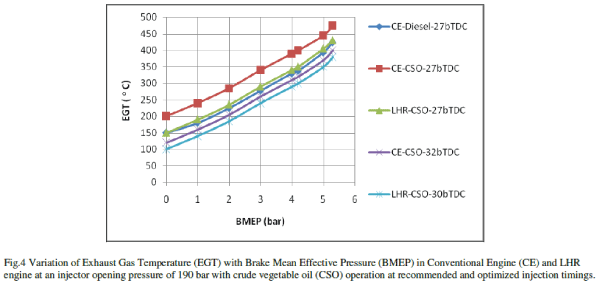 |
| From the Table 8, it was observed that exhaust gas temperature (EGT) with LHR engine with pure diesel operation was higher in comparison with conventional engine at recommended (50oC) and optimized injection timings (50o C). This was due to reduction of ignition delay with pure diesel operation with LRH engine as hot combustion chamber was maintained by LHR engine. This indicated that heat rejection was restricted through the piston and liner, thus maintaining the hot combustion chamber as result of which the exhaust gas temperature increased. |
| EGT with LHR engine with biodiesel operation was marginally lower in comparison with conventional engine at recommended (45oC) and optimized injection timings (20oC). This was due to reduction of ignition delay in the hot environment with the provision of the insulation in the LHR engine, which caused the gases expand in the cylinder giving higher work output and lower heat rejection. |
| Exhaust gas temperature decreased with increase of injector opening pressure and injection timing with both versions of the engine with vegetable oil which confirmed that performance increased with increase of injector opening pressure. This was due to improved spray characteristics of the fuel with improved air fuel rations [23]. |
| From the Table.8, it is noticed that the exhaust gas temperatures of preheated vegetable oil were higher than that of normal vegetable oil, which indicates the increase of diffused combustion [23] due to high rate of evaporation and improved mixing between fuel and air. Therefore, as the fuel temperature increased, the ignition delay decreased and the main combustion phase (that is, diffusion controlled combustion) increased [23] , which in turn raised the temperature of exhaust gases. |
RESULTS |
 |
| It can be observed in Figure 5 that volumetric efficiency decreased with an increase of brake mean effective pressure in both versions of the engine with vegetable oil operation. This was due to increase of gas temperature [23] with the load. At the recommended injection timing, volumetric efficiency in the both versions of the engine with vegetable oil operation decreased at all loads when compared with conventional engine with pure diesel operation. Volumetric efficiency mainly depends on speed of the engine, valve area, valve lift, timing of the opening or closing of valves and residual gas fraction rather than on load variation. Hence with vegetable oil operation with conventional engine, volumetric efficiency decreased in comparison with pure diesel operation on conventional engine, as residual gas fraction increased. This was due to increase of deposits with vegetable oil operation with conventional engine. The reduction of volumetric efficiency with LHR engine was due increase of temperature of incoming charge in the hot environment created with the provision of insulation, causing reduction in the density and hence the quantity of air with LHR engine. Volumetric efficiency increased marginally in conventional engine and LHR engine at optimized injection timings when compared with recommended injection timing with vegetable oil. This was due to decrease of un-burnt fuel fraction in the cylinder leading to increase in volumetric efficiency in conventional engine and reduction of gas temperatures [23] with LHR engine. This was due to decrease of combustion chamber wall temperatures with improved air fuel ratios [23] |
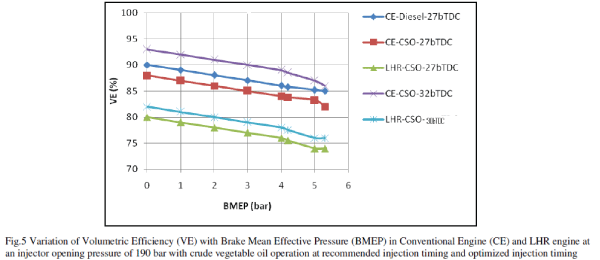 |
| From Table 9, volumetric efficiency increased with increase of injector opening pressure and with advanced injection timing in both versions of the engine with vegetable oil. This was also due to improved fuel spray characteristics and evaporation at higher injector opening pressures leading to marginal increase of volumetric efficiency. This was also due to the reduction of residual fraction of the fuel, with the increase of injector opening pressure. Increase of volumetric efficiency depends on combustion chamber wall temperature, which in turn depends on exhaust gas temperatures. With increase of injector opening pressure, exhaust gas temperatures decreased and hence volumetric efficiency increased. |
| Preheating of the crude vegetable oil marginally decreased volumetric efficiency, when compared with the normal temperature of crude vegetable oil, because of reduction of bulk modulus, density of the fuel and increase of exhaust gas temperatures. |
| Table.9 denotes that volumetric efficiency were lower (8% and 11%) with LHR engine with pure diesel operation at recommended and optimized injection timings respectively in comparison with conventional engine. |
| Volumetric efficiencies were lower (11% and 13%) with LHR engine with vegetable oil operation at recommended and optimized injection timings respectively in comparison with conventional engine. |
| Volumetric efficiencies were lower with LHR engine with vegetable oil operation than diesel operation. This was because of increase of exhaust gas temperatures and accumulation fuel deposits on combustion chamber walls. |
 |
| Curves from Figure 6 indicate that that coolant load (CL) increased with increase of brake mean effective pressure in both versions of the engine with test fuels. |
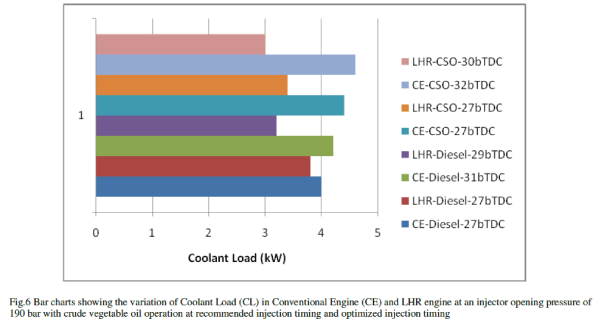 |
| Coolant load increased with advanced injection timing with CE and decreased in LHR engine with vegetable oil operation. In case of conventional engine, un-burnt fuel concentration reduced with effective utilization of energy, released from the combustion, coolant load with vegetable oil operation increased marginally at all loads, with increase of gas temperatures, when the injection timing was advanced to the optimum value. However, the improvement in the performance of the conventional engine was due to heat addition at higher temperatures and rejection at lower temperatures, while the improvement in the efficiency of the LHR engine was due to recovery from coolant load at their respective optimum injection timings with test fuels. Coolant load decreased in LHR engine because of improved air fuel ratio with which gas temperatures [23] decreased. |
| Table 10 indicates that coolant load with LHR engine with pure diesel operation was lower (5% and 18%) at recommended and optimized injection timings respectively in comparison with conventional engine. This was due insulation provided with LHR engine. |
| Coolant load with LHR engine with biodiesel operation was lower (22% and 16%) at recommended and optimized injection timings respectively in comparison with conventional engine. This was due insulation provided with LHR engine. |
| Reduction of coolant load was higher with LHR engine with vegetable oil operation than diesel operation. This was because of higher value of gas temperatures with diesel operation as its calorific value is high. |
| it is seen that coolant load increased marginally in the conventional engine while it decreased in the LHR engine with increasing of the injector opening pressure with test fuels. This was due to the fact with increase of injector opening pressure with conventional engine, increased nominal fuel spray velocity resulting in better fuel-air mixing with which gas temperatures increased. The reduction of coolant load in the LHR engine was not only due to the provision of the insulation but also it was due to better fuel spray characteristics and increase of air-fuel ratios causing decrease of gas temperatures and hence the coolant load. . Coolant load decreased marginally with preheating of biodiesel. This was due to improved air fuel ratios [23] with improved spray characteristics. |
 |
| Figure 7 indicates at recommended injection timing, sound intensities marginally increased in CE with vegetable oil operation in comparison with CE with pure diesel operation. Higher viscosity, bulk modulus, duration of combustion and poor volatility caused moderate combustion of vegetable oil leading to generate higher sound levels. LHR engine decreased sound intensity when compared with pure diesel operation on CE. This was because of hot environment in LHR engine improved the combustion of vegetable oil. This was also due to decrease of density and bulk modulus of fuel at higher temperatures leading to produce lower levels of sound with LHR engine. When injection timings were advanced to optimum, sound intensities decreased for both versions of the engine, due to early initiation of combustion and improved air fuel ratios [23]. |
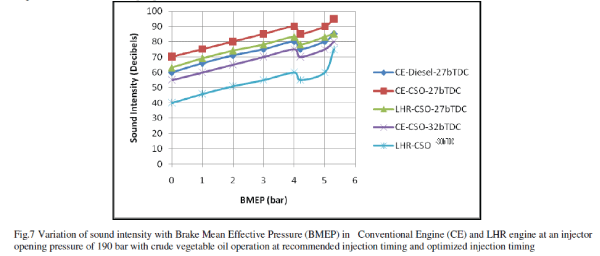 |
| Table 11 denotes that the Sound intensity decreased with increase of injector opening pressure for both versions of the engine with the vegetable oil. This was because of improved combustion with increased air fuel ratios [23]. This was also due to simultaneous increase of bulk modulus and density. This was due to improved spray characteristic of the fuel, with which there was no impingement of the fuel on the walls of the combustion chamber leading to produce efficient combustion. Sound intensities were lower at preheated condition of vegetable oil when compared with their normal condition. This was due to improved spray characteristics, decrease of density and reduction of bulk modulus of the fuel. |
 |
| Table 11 indicates that sound intensity with LHR engine with pure diesel operation was marginally higher (6% and 6%) at recommended and optimized injection timings respectively in comparison with conventional engine. This was due deterioration in the combustion due to reduction of ignition delay. . Coolant load with LHR engine with vegetable oil operation was lower (16% and 13%) at recommended and optimized injection timings respectively in comparison with conventional engine. This was due improved combustion with improved air fuel ratios [23]. |
| B. Exhaust Emissions |
| Figure 8 indicates that the value of smoke intensity increased from no load to full load in both versions of the engine with test fuels. During the first part, the smoke level was more or less constant, as there was always excess air present. However, in the higher load range there was an abrupt rise in smoke levels due to less available oxygen, causing the decrease of air-fuel ratio [18], leading to incomplete combustion, producing more soot density. Marginal increase of smoke levels at all loads with CE fuelled with vegetable oil was observed when compared with pure diesel operation on CE. This was due to the higher value of ratio of C/H vegetable oil [C=Number of carbon atoms, H= Number of hydrogen atoms in fuel composition C18H32O2], 0.56 when compared with pure diesel (0.45). The increase of smoke levels was also due to decrease of air-fuel ratios [23] and volumetric efficiency. Smoke levels were related to the density of the fuel. Smoke levels were higher with vegetable oil due to its high density. |
| However, LHR engine marginally decreased smoke levels due to efficient combustion and less amount of fuel accumulation on the hot combustion chamber walls of the LHR engine at different operating conditions of the vegetable oil compared with the CE. Smoke levels decreased at the respective optimum injection timing with both versions of the engine with vegetable oil. This was due to initiation of combustion at early period with both versions of the engine. |
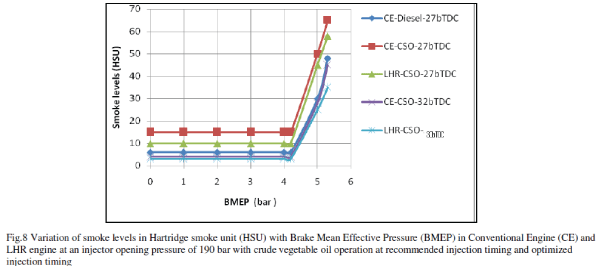 |
| Data from Table 12 shows that smoke levels decreased with increase of injection timing and the injector opening pressure in both versions of the engine, with different operating conditions of the vegetable oil. This was due to improvement in the fuel spray characteristics with higher injector opening pressures and increase of air entrainment, at the advanced injection timings, causing lower smoke levels. Preheating of the vegetable oils decreased smoke levels in both versions of the engine, when compared with normal temperature of the vegetable oil. This was due to i) the reduction of density of the vegetable oil, as density was directly related to smoke levels, ii) the reduction of the diffusion combustion proportion in conventional engine with the preheated vegetable oil, iii) reduction of the viscosity of the vegetable oil, with which the fuel spray does not impinge on the combustion chamber walls of lower temperatures rather than it was directed into the combustion chamber. |
| Table 12 denotes that smoke levels with LHR engine with pure diesel operation were (15% and 50%) at recommended and optimized injection timings respectively in comparison with conventional engine. This was due fuel cracking at high temperatures because of insulated components. |
| Coolant load with LHR engine with vegetable oil operation was lower (23% and 33%) at recommended and optimized injection timings respectively in comparison with conventional engine. This was due improved combustion with improved air fuel ratios [23]. This showed that LHR engine was more suitable for vegetable oil operation as it improved thermal efficiency and reduced smoke levels. |
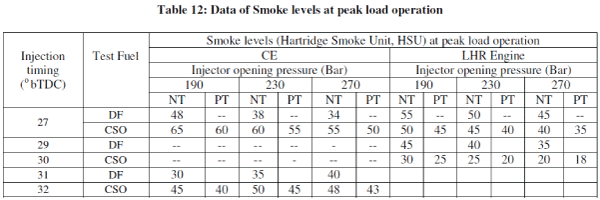 |
| Availability of oxygen and high temperatures are favorable conditions to form NOx levels. Figure 9 indicates for both versions of the engine, NOx concentrations raised steadily as the fuel/air ratio increased with increasing BP/BMEP, at constant injection timing. At part load, NOx concentrations were less in both versions of the engine. This was due to the availability of excess oxygen. At remaining loads, NOx concentrations steadily increased with the load in both versions of the engine. This was because, local NOx concentrations raised from the residual gas value following the start of combustion, to a peak at the point where the local burned gas equivalence ratio changed from lean to rich. At peak load, with higher peak pressures, and hence temperatures, and larger regions of close-to-stoichiometric burned gas, NOx levels increased in both versions of the engine. Thus NOx emissions should be roughly proportional to the mass of fuel injected (provided burned gas pressures and temperature do not change greatly). |
| It is noticed that NOx levels were lower in CE while they were higher in LHR engine at different operating conditions of the vegetable oil at the peak load when compared with diesel operation. This was due to lower heat release rate because of high duration of combustion causing lower gas temperatures [32] with the vegetable oil operation on CE, which reduced NOx levels. The production of more NOx with vegetable oil in LHR engine is also attributable to an inadvertent advance of fuel injection timing due to higher bulk modulus of compressibility, with the in-line fuel injection system [32]. Vegetable oil is less compressible due to the higher bulk modulus, causing nozzle opening pressure to be exceeded prematurely. This earlier injection leading to advancement in combustion timing in which stronger premixed combustion phase follows. This in turn increases the peak in-cylinder temperature, which increases the rate of NOx formation in LHR engine. Increase of combustion temperatures with the faster combustion and improved heat release rates [23] associated with the availability of oxygen in LHR engine caused higher NOx levels |
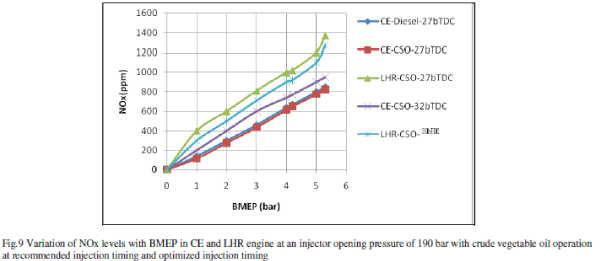 |
| The data in Table 13 shows that, NOx levels increased with the advancing of the injection timing in conventional engine with different operating conditions of vegetable oil. Residence time and availability of oxygen had increased, when the injection timing was advanced with vegetable oil which caused higher NOx levels in conventional engine. This was due to higher value of bulk modulus of the vegetable oil, which cause changes in injection timing (advanced injection timing) giving rise to higher NOx levels. However, NOx levels decreased marginally with increase of injection timing with in LHR engine at different operating conditions of vegetable oil. This was due to decrease of gas temperatures [23] with the increase of air-fuel ratios [23]. |
| NOx levels increased with increase of injector opening pressure with different operating conditions of vegetable oil. With the increase of injector opening pressure, fuel droplets penetrate and find oxygen counterpart easily. Turbulence of the fuel spray increased the spread of the droplets which caused increase of gas temperatures [23] marginally thus leading to decrease in NOx levels. Marginal decrease of NOx levels was observed in LHR engine, due to decrease of combustion temperatures [23] with improved air fuel ratios [23]. |
| The fuel spray properties may be altered due to differences in viscosity and surface tension. The spray properties affected may include droplet size, droplet momentum, degree of mixing, penetration, and evaporation. The change in any of these properties may lead to different relative duration of premixed and diffusive combustion regimes. Since the two burning processes (premixed and diffused) have different emission formation characteristics [32], the change in spray properties due to preheating of the vegetable oil were lead to reduction in NOx formation. As fuel temperature increased, there was an improvement in the ignition quality, which caused shortening of ignition delay. A short ignition delay period lowered the peak combustion temperature [32] which suppressed NOx formation. Lower levels of NOx was also attributed to retarded injection, improved evaporation, and well mixing of preheated vegetable oil due to its low viscosity at preheated temperature of 95°C. Hence lower levels of NOx were observed with preheated vegetable oil in comparison with normal vegetable oil. |
| Table 13 denotes that NOx levels with LHR engine with pure diesel operation were higher (41% and 5%) at recommended and optimized injection timings respectively in comparison with conventional engine. This was increase of gas temperatures because of insulated components. |
| NOx levels were higher with LHR engine (75% and 42%) at recommended and optimum injection timing when compared with CE with vegetable oil operation. |
| The reason with lower value of NOx levels with pure diesel operation was its fuel composition. |
 |
| C. Combustion Characteristics |
| From Table 14, it is observed that peak pressures were compatible in conventional engine while they were higher in LHR engine at the recommended injection timing and pressure with vegetable oil operation, when compared with pure diesel operation on conventional engine. This was due to higher value of bulk modulus of the vegetable oil. |
| PP was slightly higher than that of diesel fuel in LHR engine, even though the CV was lower with vegetable oil. The vegetable oil advanced the peak pressure position as compared to fossil diesel because of its higher bulk modulus and compatible cetane number. This shift was mainly due to advancement of injection due to higher density or bulk modulus [32] and earlier combustion due to shorter ignition delay caused by higher cetane number of vegetable oil in the hot environment provided by LHR engine. When, a high density (or high bulk modulus) fuel was injected, the pressure wave traveled faster from pump end to nozzle end, through a high pressure in-line tube. This caused early lift of needle in the nozzle, causing advanced injection [32]. Hence, the combustion took place very close to TDC and the peak pressure slightly high due to existence of smaller cylinder volume near TDC. But in case of conventional engine, combustion was not proper with high viscous fuel like vegetable oil and hence PP were always lower than those of diesel fuel. |
| The advantage of using LHR engine for vegetable oil was obvious as it could burn low cetane and high viscous fuels. |
| Preheated vegetable oil registered marginally lower value of PP than normal vegetable oil. This was due to reduction of ignition delay and bulk modulus of the fuel. |
| Peak pressures increased with the increase of injector opening pressure and with the advancing of the injection timing in both versions of the engine, with the test fuels. Higher injector opening pressure produced smaller fuel particles with low surface to volume ratio, giving rise to higher value of peak pressure. |
| With the advancing of the injection timing to the optimum value with the conventional engine, more amount of the fuel accumulated in the combustion chamber due to increase of ignition delay as the fuel spray found the air at lower pressure and temperature in the combustion chamber. When the fuel- air mixture burns, it produced more combustion temperatures and pressures due to increase of the mass of the fuel. |
| With LHR engine, peak pressures increases due to effective utilization of the charge with the advancing of the injection timing to the optimum value. It is observed that, peak pressure was higher and time of occurrence of peak pressure (TOPP) was lower with vegetable oil operation even though vegetable oil has lower calorific value than that of diesel, as vegetable oil has higher bulk modulus and compatible cetane number. |
| The value of TOPP decreased with the advancing of the injection timing and with increase of injector opening pressure in both versions of the engine, at different operating conditions of the vegetable oil. TOPP was found to be higher with different operating conditions of the vegetable oil in conventional engine, when compared with pure diesel operation on conventional engine. |
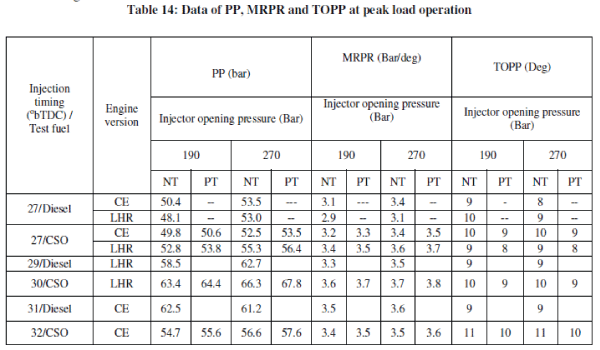 |
| Preheating of the vegetable oil showed lower TOPP, compared with vegetable oil at normal temperature. This once again confirmed by observing the lower TOPP and higher peak pressure (PP), the performance of the both versions of the engine improved with the preheated vegetable oil form compared with the normal vegetable oil. |
| Maximum rate of pressure rise (MRPR) showed similar trends as those of peak pressure in both versions of the engine at different operating conditions of the vegetable oil. This trend of increase of MRPR indicated improved and faster energy substitution and utilization by vegetable oil in LHR engine, which could replace 100% diesel fuel. However, these combustion characters were within the limits (the engine was not subjected to knocking) hence the vegetable oil can be effectively substituted for diesel fuel. |
CONCLUSIONS |
| Relatively, peak BTE increased by 11%, at peak load operation-brake specific energy consumption decreased by 4%, exhaust gas temperature compatible, volumetric efficiency decreased by 11%, coolant load decreased by 20%, sound intensity decreased by 12%, smoke levels decreased by 27% and NOx levels increased by 49% with vegetable oil operation on LHR engine at its optimum injection timing, when compared with pure diesel operation on conventional engine at manufacturer’s recommended injection timing. |
RESEARCH FINDINGS |
| LHR engine with ceramic coated cylinder head improved the performance with crude cotton seed in comparison with CE with pure diesel operation. However, it increased NOx levels drastically Hence further work on reduction of NOx levels is necessary. |
ACKNOWLEDGMENTS |
| Authors thank authorities of Chaitanya Bharathi Institute of Technology, Hyderabad for providing facilities for carrying out research work. Financial assistance provided by All India Council for Technical Education (AICTE), New Delhi, is greatly acknowledged. |
References |
|